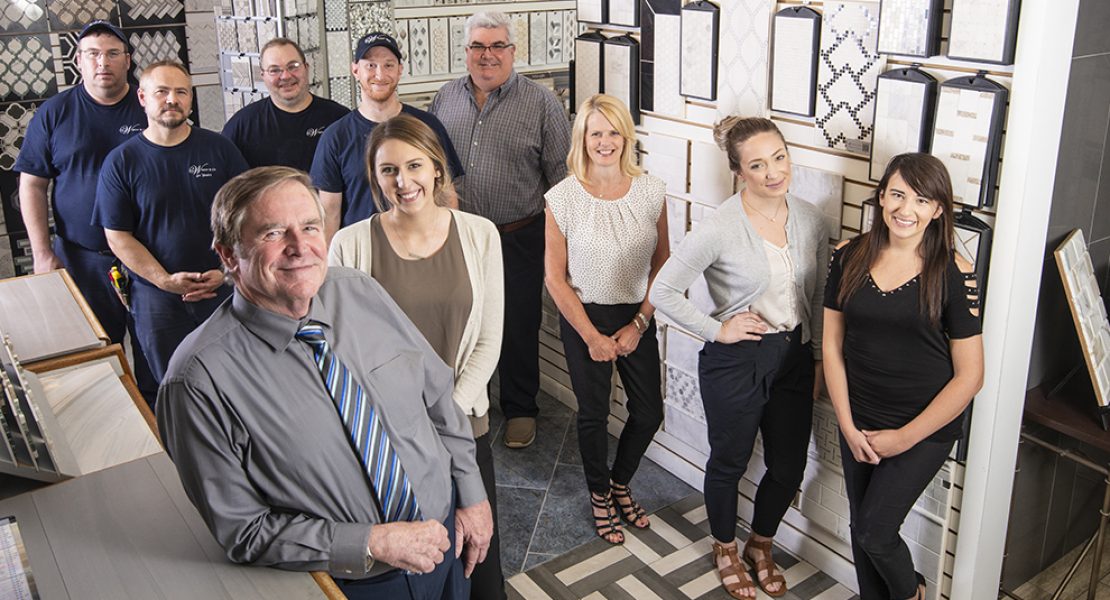H. Winter & Co. Tile

Herman Winter says his business may look somewhat deceiving from the outside, but one step inside will reveal a blast of color, textures, and possibilities from one of the oldest forms of home decorating.
H. Winter & Co. (890 N. Gilmore St., Allentown), a tile wholesaler that Winter’s father started in 1975, offers four showrooms dedicated to backsplashes, floors, and walls. Customers can tap into their creative imaginations by choosing colors, patterns, and textures with an expert design staff that can guide them through an endless mosaic of design options in domestic and imported porcelain tile from England, Spain, and Italy.
“My father was working for another tile company and decided to go on his own,” says Winter, who joined the company in 1986. “Making customers satisfied with a quality product at a fair price has always been our goal.”
There’s nothing high pressure, either, he insists, because “tile is a luxury, not a necessity. The first thing that can be cut in a house design is the tile.”
But once a homeowner decides on tile, it takes time and energy to work through selecting styles and grout, often the last part of the process that no one particularly enjoys, Winter says. “People don’t like grout,” he chuckles. “If I could get away without selling grout, I’d be the happiest man in the world.”
The tile business has changed dramatically since H. Winter & Co. opened with about two dozen colors to choose from and sizes limited to 4×4-inch and 1×1-inch tiles. It’s now expanded to 12x24s, 8x36s, and larger tiles.
“People are advised by their contractor to come in to make their choices. On their first visit, they’re just overwhelmed and confused,” Winter says. “We don’t push people; we understand that confusion. We have samples in the back warehouse and make sure each customer can take a piece home to see it in their own lighting in their own home.
“There are thousands of possibilities in here,” he adds. “You can take a basic tile and change the whole complexion of the look by adding decoratives or glass pieces, or by changing the layout. It can change the whole look of a room.”
Using digital technology, multiple ink jet heads can mimic different surfaces, adding to the array of possibilities. “You can get different finishes on the tile to duplicate stone or hardwood and other looks, and every year it increases,” Winter says. “It’s really unbelievable what can be done with tile today.”
Tile can also be laid atop heating elements, so your wet feet have a warm place to land after stepping out of the shower on a frosty winter morning. “Tile is popular because it’s easy to clean, and it doesn’t stain or scratch (unless it’s a high-gloss finish),” Winter says. “But people used to reject it because it was cold to the touch. Not anymore.”
“It’s really unbelievable what can be done with tile today.”
While home builders may not initially include tile, it’s something that homeowners often turn to later on, Winter says. “A lot of our business is word of mouth. They come back later on to do a bathroom or a backsplash,” he says. “We have 13 employees, and our staff is attuned to new installation products that allow us to put tile where we couldn’t before. And they have a great knack for looking at ideas and concepts and putting them together. We have all the equipment, expertise, and products needed for a quality job. It’s been that way for nearly 45 years.”
Tile Tips & Trends
Kailyn Bachman, showroom manager at H. Winter & Co., offers some perspective on the history of tile and advice on how to use it effectively.
How long has tile been used for decorative purposes?
The earliest documented example of tile dates back to 13th century B.C. as a glazed brick. Following its debut, tile was used in temples, swimming pools, mosques, and mausoleums. Shortly thereafter, small cut or broken pieces of tile were used to create larger, intricate patterns forming mosaics. Although the manufacturing process has greatly advanced with technology, some of the patterns you see today are inspired by these archaic designs and patterns.
What are some of the emerging trends in the tile world?
Wood tones, patterned floors, undulated surfaces (think: the subway tile look), and metallic accents are among the latest trends in the tile world. If you follow the interior design industry, you may have noticed wood grain has been making a comeback in a big way. Wood look tiles can help you achieve this look, and using a wood look tile on your shower walls, for example, is a creative way to add warmth and texture. Pattern floors, ranging from traditional to geometric have been a staple in our showroom and can be used to add interest or personality to an otherwise simple space. Likewise, undulated tiles add character and texture with their high sheen and crafted surface, offering a unique spin on the traditional subway tile. Lastly, brass is back! Brass, mirrors, and other metallic accents are being used in mosaics, often paired with marble offering a modern spin to a classic staple.
What’s more practical: hardwood or tile floors?
Initially, tile is considered an upgrade for both material and labor; but in the long run, it’s more practical due to the lack of maintenance. On the other hand, hardwood can scratch and dent easily, needing to be refinished approximately every 10 years. Customers are often concerned about the temperature of tile, but with recent advancements, in-floor heat has become more cost effective using our new WarmUp system. If you want the look of wood with the durability of tile, rest easy—one of our bestselling styles are tiles that look like hardwood. These planks emulate wood floors without the maintenance and are available in a variety of styles, such as traditional, rustic, and contemporary.
What kind of tile would you recommend for a kitchen backsplash?
Your kitchen backsplash will act as a bridge between your cabinetry and countertops. To decide if you would prefer a simple backsplash, or something more prominent, you must first decide what you want the focal point of your kitchen to be. For example, if you have chosen a busy or exotic countertop, I would recommend a more simple and solid backsplash, allowing the countertops to be the star of the show. But if your countertop is relatively simple, a patterned backsplash could introduce more color and texture to your space, creating a striking focal point.





















